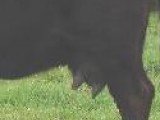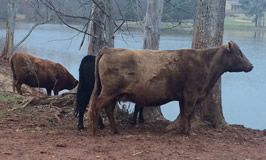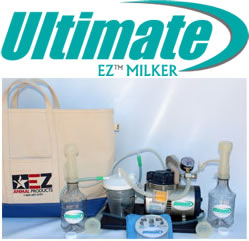SOME COWS HAVE EXTRA TEATS:
Literature sources state as many as 50% of domestic cattle have more than four teats, known as supernumerary teats. Extra teats may be part of a very small milk gland, or have no milk gland underneath. This is not unique to cattle, and is one of the mysteries of the development of mammals; in fact, many humans have more than two nipples, but do not realize it, thinking they have a little brown mole on their chest or abdomen.
Normal teats and extra teats follow the same “milk line.” The milk line is two imaginary rows along which teats can form on the developing fetus. This is why the extra teats on cattle typically form in a line behind the primary four teats, in the same row formation.
Dairy cattle are selected for easy machine-milking, and “show cattle” are selected for a clean appearance. Both goals usually result in the removal of extra teats, preferably in a very young calf. Since most commercial dairy cattle are dehorned as calves, dairymen simply check for extra teats at the time of dehorning, and, if present, snip them off.
HOW ARE EXTRA TEATS INHERITED? This has never been determined. It is clear extra teats are not a single-gene trait that can be easily “bred out” like, say, PHA. Some articles refer to an expansion of genes that occurred when cattle began to be selected for milk long ago. Others have documented an increased frequency of extra teats in calves born to older cows, and proposed that exposure of the developing fetus to varying hormone levels may increase or decrease the likelihood of extra teats. Since it is unknown how the trait is inherited, how many genes contribute, or what other factors are involved; it is very difficult to select against.

This dry cow still shows a poor rear udder attachment, causing the udder to tip forward. Funnel teats are wedge shaped on a dry cow, and balloon out during the first couple weeks of each lactation.
DO EXTRA TEATS MEAN THE ANIMAL HAS A POOR UDDER? A poor rear udder attachment causes the cow’s udder to tip forward. Weak median suspension causes the teats to point out to the sides. A poor front udder attachment reduces capacity. Funnel teats make it difficult for a newborn calf to nurse and receive adequate colostrum. All these defects become increasingly worse with each lactation, making an udder prone to injury and difficult to milk or nurse. These defects are virtually unknown in commercial dairy cattle, but plague our Dexters. Extra teats, on the other hand, are largely a cosmetic issue and can be snipped off, if desired. They cause no actual harm to the animal.
DO EXTRA TEATS MEAN THE ANIMAL IS MORE LIKELY TO PRODUCE TWINS? No.
SOME COWS HAVE MISSING TEATS:
The opposite situation is when an animal has less than four teats. This is a much rarer occurrence, and has several causes.
In some cases of a congenitally “three-teated-cow,” the gland is present but has no corresponding teat, due to a problem that occurred within the developing fetus. It is usually a front teat that is missing. The lack of a teat will result in a quarter that will engorge with milk when the cow freshens, but since there is no exit point for the milk, the milk will be resorbed and the quarter will cease to be active. This cycle will usually repeat for each lactation.
Occasionally, a teat is bitten-off by another calf sucking on a young heifer in groups of bottle-fed calves. This is different than a congenitally absent teat.
Another cause of a missing teat is actually a severe case of poor teat spacing. If you look at an affected animal closely, two teats from the same side of the udder are so close together, they have actually fused. Sometimes there is evidence of the fusion: There may be two orifices in the “super-teat,” or there may even be a vertical cleft. Although this is still an issue with fetal development, it is not nearly as random as an absent teat. Typically, the fused teat occurs in bloodlines that have obvious issues with teat spacing, and the cow often has closely spaced teats on the opposite side.
It is important to note that teats may also be amputated in an adult animal due to poor udder conformation (pendulous udders can be stepped on when the animal is getting up) and also may be lost as a result of extreme frost bite.
NOTES: Udder conformation is of great importance in both beef and dairy cattle, as proper udder conformation allows the animal to serve a long productive life.
Extra teats are common in cattle, can be easily removed, and have very little impact on the animal if they are not removed. Udder selection in Dexters has been lacking through the years and there are very few Dexters who have extra teats as their only udder imperfection.
Missing teats are much rarer, but probably more serious. Sometimes missing teats represent a fused teat due to poor teat spacing in the bloodline. Poor teat spacing makes it difficult to milk the animal by hand or machine; and in severe cases, the calves must suck two teats at once.
Udder attachments must be strong in order to keep an animal productive for the long productive lifespan we expect from Dexters. Without proper udder support a cow’s udder will fall below her hocks; risking injury, limiting movement, and making it difficult for her to be milked or nurse a calf.



Hi Gabriella: Another great article – could you be called the “myth buster”?
Always the pictures with the explanation – always a great job on helping all
of us.
Jimmie – see I do read you webpage all the time.
I have dairy goats. My husband said that I can only get a dairy cow if she is small enough for me to handle. I have been doing research on the dexter breed and believe a dual cow is perfect for me. I want to purchase a calf from a breeder that breeds for milking dual bloodlines. Will you have a calf available in the spring 2015.
Yes, keep checking our website sale page. Or, if you want to go on the waiting list for something specific, you can email bellefourche@aol.com.
hello i worked with cows all of my life it obviouse they have four teats but you are right because they have sometimes have extra and we know someone who has a cow with one tit and still feeding a calf this is in the wolly wilds of scotland
I have a cow with a small extra tit on the back of her bag. She has a 5 day old calf that insists on sucking the extra tit. I don’ t know if he is getting any milk. Her other tits are large and he has difficulties sucking them. Is it possible he is getting milk from the small extra tit? Her bag seems to go down somewhat.
She may have funnel teats that are too large for a newborn calf to nurse. Funnel teats enlarge when the cow freshens and when the calf is weaned. They may look fairly normal otherwise. If your cow has funnel teats, the calf may get a small amount of milk from the extra teat, but will not get an adequate amount of milk until he is old enough to get one of the oversized primary teats into his mouth. This usually happens in a couple days, but it means the calf will be deprived of adequate colostrum (his source of passive immunity). A calf who does not get adequate colostrum will be more likely to become ill. Funnel teats are also hereditary. For these reasons, cows with funnel teats are not used for breeding in our herd.